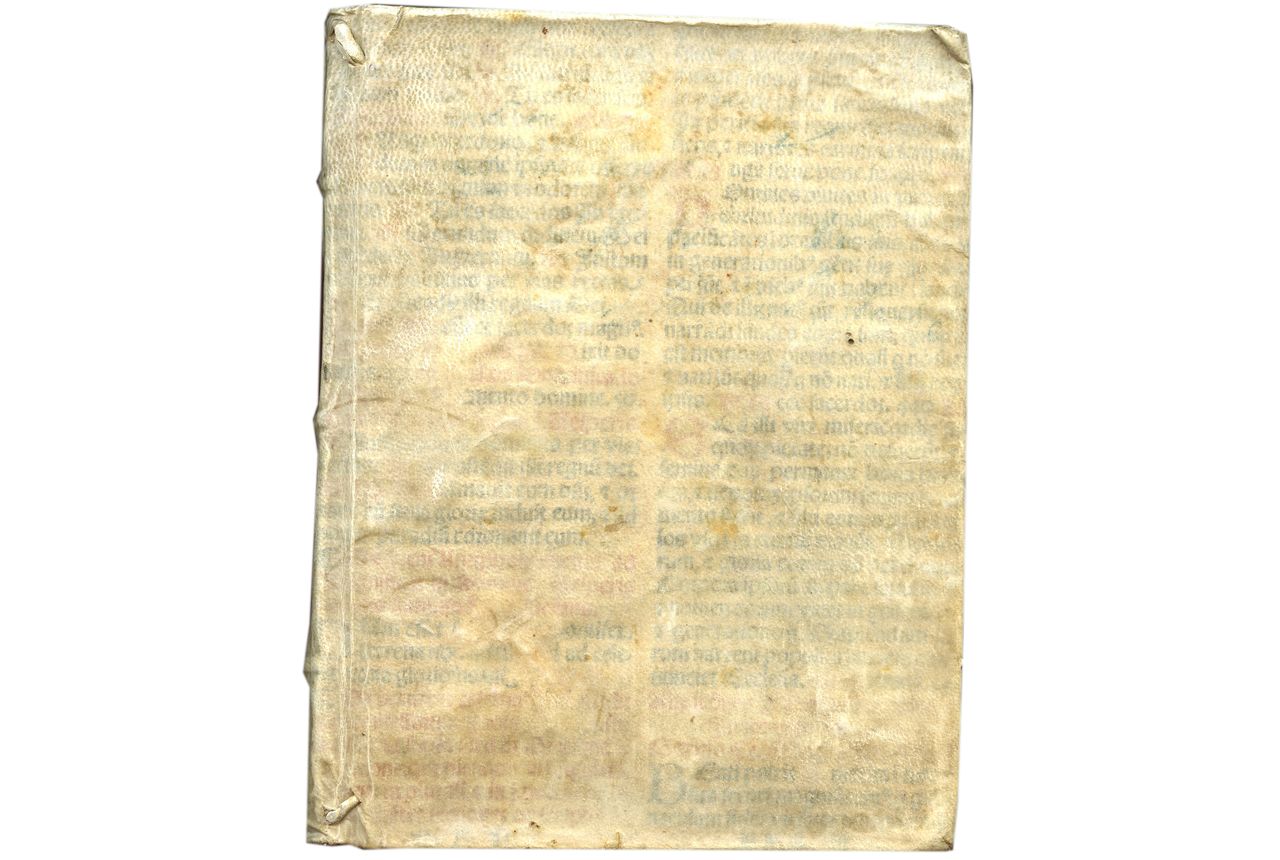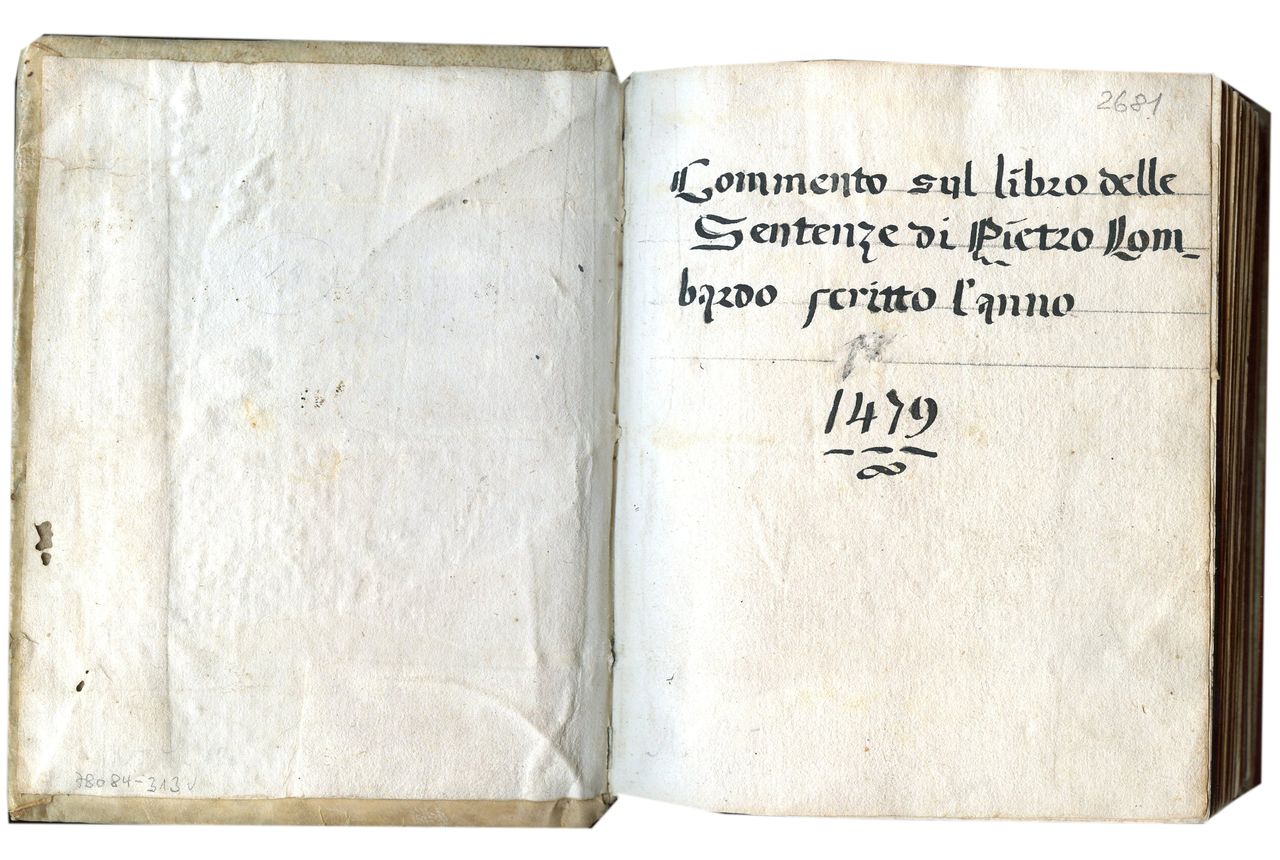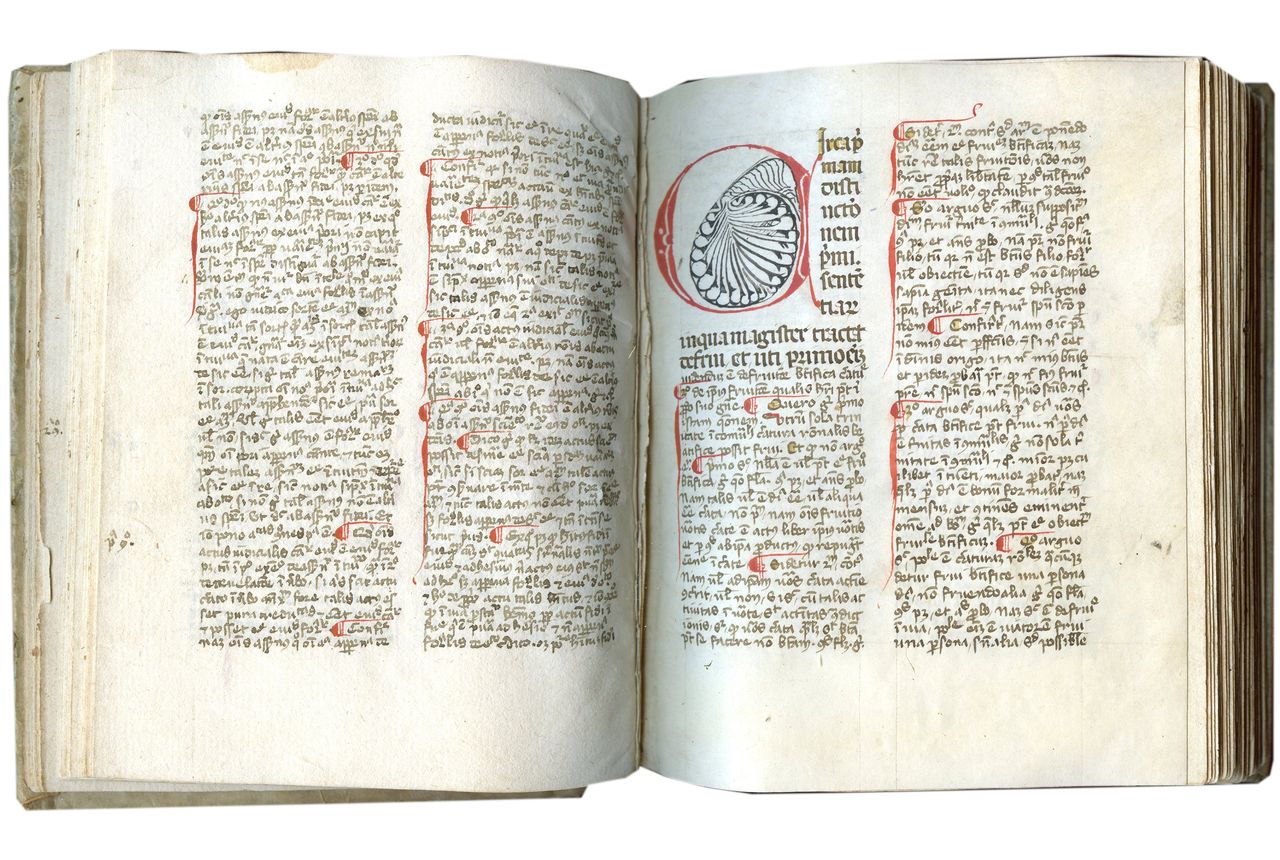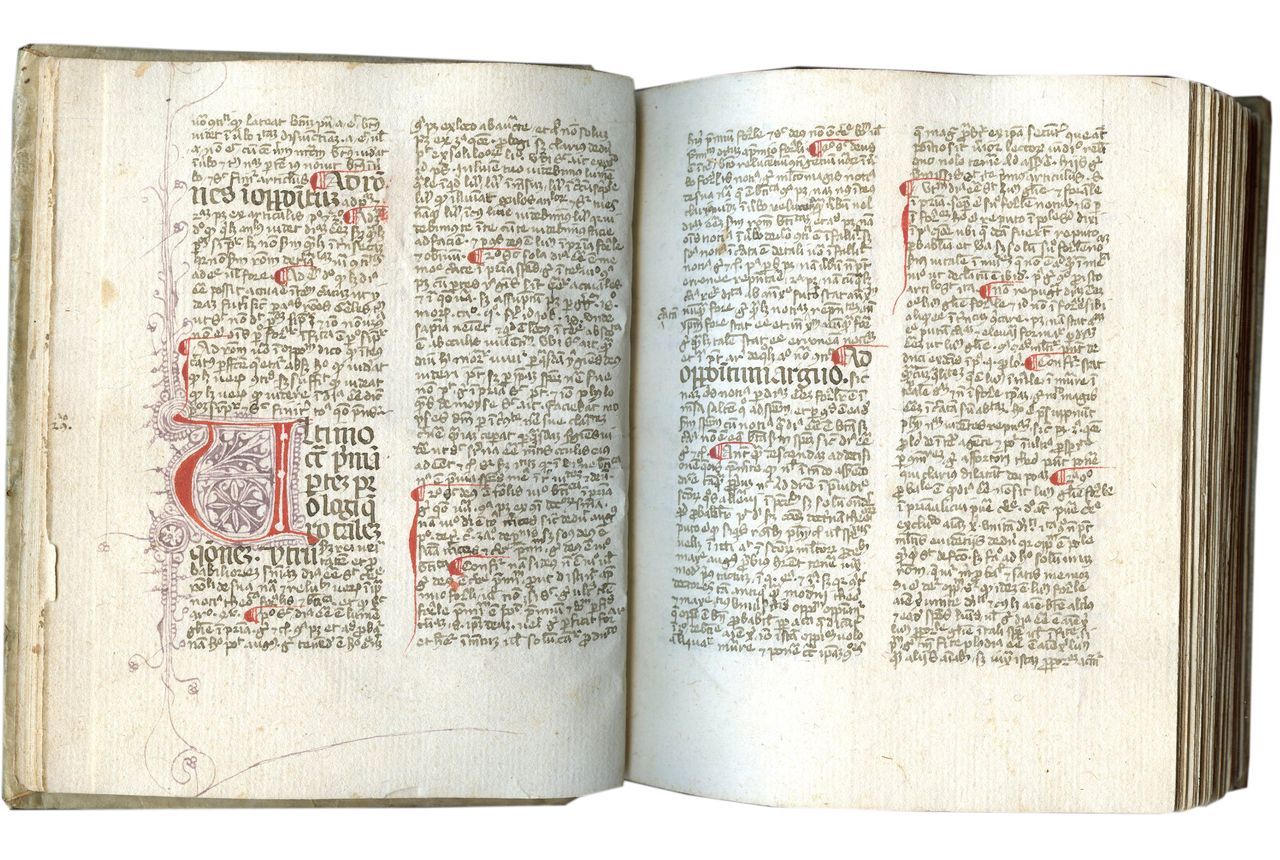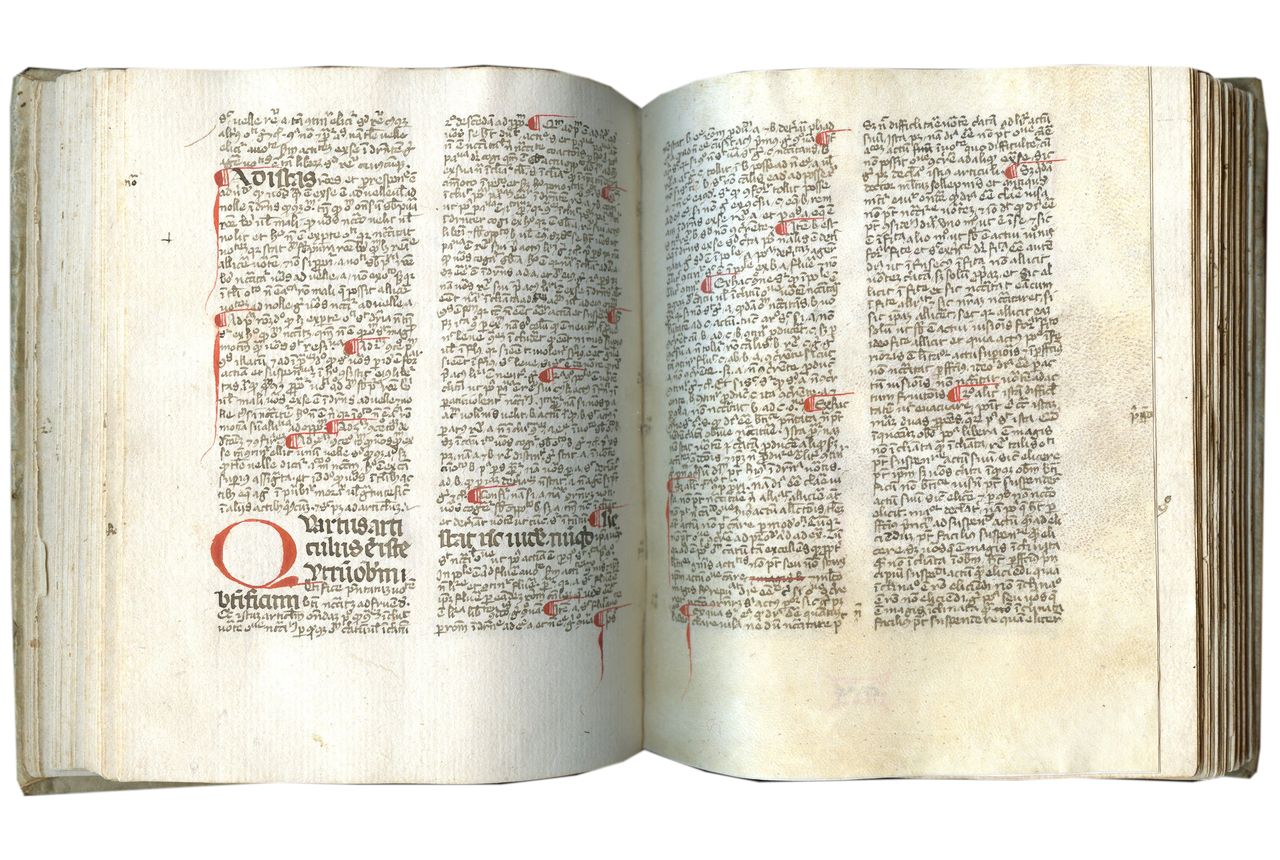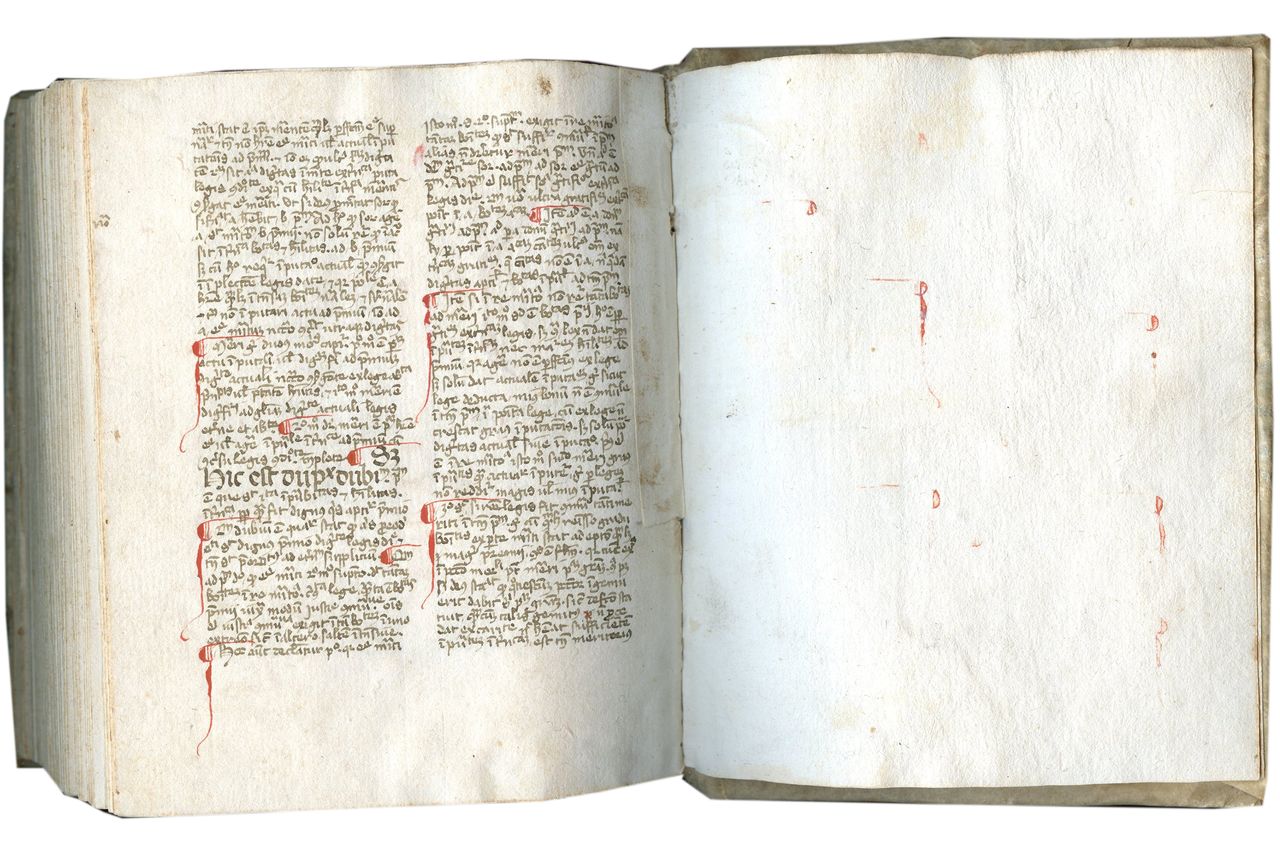i (unnumbered paper) + 124 + i (unnumbered paper), quires 1-3 (through f. 24v) are all paper, thereafter, paper and parchment alternate, so that quires begin with parchment, and parchment is used for the middle bifolia, watermark, partial and obscured by text, possibly a bow, not in Piccard, incorrect modern foliation in pencil, top, outer corner, 1-123, with f. 10bis, the text suggests that the manuscript once included additional quires, no missing, at the beginning and end (collation, i10 ii10 [beginning f. 10bis] iii5 [structure uncertain] iv6 v10 [-1, before f. 31, with loss of text] vi-ix10 x10 [-1, before f. 76, with loss of text] xi-xiii10 xiv10 [-10, following f. 123, with loss of text]), horizontal catchwords, middle, lower margin, decorated in quires 1, 2, 6, 9, 12, and 13, see ff. 10v, 19, 45v, 75v, 104v, and 114v, no signatures, written below the top line, with the beginning of sections copied in a larger rounded southern gothic book hand, and the remainder of the commentary copied in a small, highly abbreviated cursive gothic script, in two columns of 35- to 31-lines (justification 115-112 x 95-90 mm.), frame ruled in lead, with the horizontal rules full across, and single full-length vertical bounding lines, no running titles, a few red rubrics, red paragraph marks delineate sections within the text, 6- to 4-line red initials, mostly undecorated, but with skillful violet pen decoration in quires 1-3, larger red initials, 15- to 12-line, at the beginning of major sections of the text, with decorative void spaces in the body of the initial, pen-infilling in black, ff. 25 and 46, in excellent, almost pristine condition, despite loss of the bottom margin on ff. 66 and 70, and the outer margin, f. 84 (no loss of text). Bound, seventeenth century (?), with vellum leaves from a printed book over pasteboard, hollow-back spine, spine with three slightly raised bands and head and tail bands, in excellent condition with slight cracking down the middle of the spine. Dimensions 160 x 128 mm.
Apart the Bible, there is no medieval theological work more commented on than the Sentences by Peter Lombard. Every medieval theology student attended lectures on the Sentences, and many medieval theologians left written commentaries on the text. Our manuscript presents an abbreviated version of the lengthy commentary on the Sentences of Peter the Lombard by the fourteenth-century Franciscan theologian, Johannes de Ripa by an unidentified author. This commentary has never appeared in print and has not yet been the subject of scholarly study; it is thus an important manuscript, and one that opens up complex textual issues warranting further study.
Provenance
1. The script and decoration suggest that this manuscript was copied in northern Italy in the fifteenth century; an inscription on the front flyleaf states that the manuscript dates from 1479: “Commento sul libro delle Sentenze di Pietro Lombardo scritto l’anno 1479”; no evidence to support this assertion is now found in the manuscript, but it may have had some support at the beginning or end of the text, both now missing, and it is certainly not impossible.
2. Spine, shelf-mark (?), B (at top), and S C (at bottom); s. XVII (?).
3. Once owned by Fürsten Portia, according to the handwritten description in German, housed with the manuscript, dated 28 January 1937.
4. Front fly-leaf, f. i, in pencil: “2681.”
5. Cutting from unidentified printed bookseller’s catalogue in German, laid in.
Text
ff. 1-123v, “//huius dona infusa creata scilicet fidem et creatorem pro etiam …., f. 25, Circa primuam distinctionem primi sententiarum in qua magister tractat de frui et uti primo enim videndum est defructione beatifica creature, secunda de ipsa fructione …, Quero igitur primo istam questionem, Utrum sola trinitate incommutabli creatura rationalis beatifice possit frui … [f. 123] Circa 16 distinctionem quero talem questionem, Vtrum creatura rationalis prius sanctificetur … est tamen meritorious//”
This is a scholastic commentary on the First Book of The Sentences of Peter the Lombard. The text now begins imperfectly in the commentary on the prologue and ends in the sixteenth distinction.
Peter Lombard (c. 1100-1160), a canon at Notre Dame, and Bishop of Paris, composed the Sentences (Libri quatuor sententiarum) around 1150. In a long series of questions, he systematically presented the whole body of theological teaching, based on the Bible and the teachings of the Fathers. His work is divided into four books, covering the Trinity, Creation, Christ and the Sacraments respectively. Together with the Bible, the Sentences became the fundamental textbook of theology faculties of medieval universities from the thirteenth through the sixteenth century. Every medieval theology student attended lectures on the Sentences, and most important medieval theologians left written commentaries on the text, ranging from Albert the Great and Thomas Aquinas, to William of Ockham and even Martin Luther (an excellent introduction to this genre is Brînzei and Schabel, 2020).
Our manuscript presents a commentary on the first Book of the Sentences, which discusses God, the Trinity, God’s attributes, Predestination and the problem of Evil, appears to be an abbreviation of the Commentary on the Sentences by Johannes de Ripa by an unknown author. Johannes of Ripa (also known as Johannes de Marchia), a fourteenth-century Franciscan theologian, studied and then taught at Paris c. 1360-80, and probably also at Amiens. His importance in medieval philosophy and epistemology is emerging gradually as scholars, including his modern editor, Andrea Nannini, study his work. There is not yet a complete edition of his very lengthy commentary on the Sentences, but parts of the text of Book 1 have been edited (see Combes and Ruello, eds. 1961 and 1970, and Nannini, ed. 2023; see also Stegmüller, 1947, no. 485, pp. 237-238).
Significantly, the text in our manuscript, which has not yet been the subject of scholarly study, appears to be independent of the abbreviation of Ripa’s text by Paul of Venice (Ruello, ed., 1999). Paul of Venice was an Augustinian Hermit, who prepared his text shortly after 1402 at Padua. The modern edition by Ruello is based on a single manuscript, Oxford, Bodleian Library, MS lat. theol. E. 34. The text in another manuscript, Vatican City, Vat. Lat 1084, ff. 1-106 (described in Pelzer, 1931, pp. 646-647), appears to be closely related to the text in the Oxford manuscript. Our manuscript includes different passages from Ripa than either of these two manuscripts. As such, it is an important witness of a work by a yet unidentified master, one that is of interest in its own right, and for the editors of John of Ripa’s work (we are very grateful to Chris Schabel, who shared with us his preliminary conclusions about the text of our manuscript and its relationship with the edition of Paul of Venice’s abbreviation, found in the Oxford manuscript, and the text of Vat. Lat 1084; in correspondence, July, 2024).
This is a working, well organized copy of the text, using a system of initials, two-sizes of script, and red paragraph marks to delineate its structure; arguments are numbered in the margin in a contemporary hand (many now cut-away), with two notes added by later readers, see ff. 102v, and 111.
Literature
Brînzei, Monica and Chris Schabel. “Critically Editing a So-Called ‘Sentences Commentary,’” in Sicut Dicit. Editing Ancient and Medieval Commentaries on Authoritative texts, ed. Stefan Schorn, Shari Boodts, Pieter De Leemans (†), LECTIO Studies in the Transmission of Texts & Ideas, 8, Turnhout, 2020, pp. 243-271.
Online, https://hal.science/hal-03175585/document
Colish, Marcia. Peter Lombard, Leiden and New York, 1994.
Combes, A. and F. Ruello, eds. Jean de Ripa. Lectura super Primum Sententiarum Prologi, [Quaestiones I & II/Quaestiones Ultimae], Textes Philosophiques du Moyen Age, vol. VIII and XVI, Paris, 1961 and 1970.
Evans, G. R., and Philipp W. Rosemann. Mediaeval Commentaries on the Sentences of Peter Lombard, Leiden and Boston, 3 vols., 2002, 2010, 2015.
Nannini, A., ed. John of Ripa. Lectura super primum sententiarum: distinctio prima, Spicilegium Bonaventuarianum 40, Rome, Editiones Collegii S. Bonaventurae ad Claras Aquas, 2023.
Pelzer, Pelzer. Codices vaticanus latini, vol. 2, pars prior, codices 79-1134, Bibliotheca Vaticana, 1931, pp. 646-647.
Ruello, F., ed. Paulus Venetus. Super Primum Sententiarum Johannis de Ripa Lecturae. Abbreviatio, Corpus Philosophorum Medii Aevi, Testi e studi XV, SISMEL, Florence, 1999.
Peter Lombard. The Sentences, translated Giulio Silano, Toronto, 2007-2008.
Perreiah, A. R. Paul of Venice. A Bibliographical Guide, Bowling Green, Ohio, 1986.
Rosemann, Phillipp. The Story of a Great Medieval Book: Peter Lombard’s Sentences, Peterborough, Ontario and Orchard Park, New York, 2007.
Stegmüller, Friedrich. Repertorium commentariorum in Sententias Petri Lombardi, Würzburg, 1947.
Online Resources
Conti, Alessandro, “Paul of Venice,” in The Stanford History of Philosophy;
http://plato.stanford.edu/entries/paul-venice/
“The Internet Guide to Master Peter Lombard,”
http://www.franciscan-archive.org/lombardus/index.html
Bibliotheca Augustana, Sententiarum libri IV
http://www.hs-augsburg.de/~harsch/Chronologia/Lspost12/PetrusLombardus/pet_s400.html
Maarten van der Heijden and Bert Roest, “Franciscan Authors, 13th-18th Century: A Catalogue In Progress, “Ioannes de Ripa; Ioannes de Marchia, fl. c. 1375”
https://franciscanauthors.rich.ru.nl/index.html
TM 339


